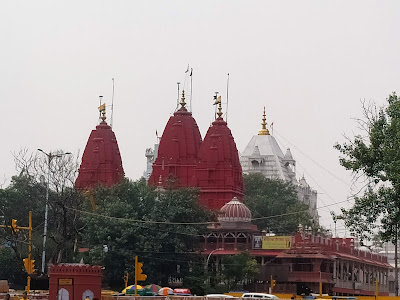SHRI DIGAMBAR JAIN LAL MANDIR, DELHI
SHRI DIGAMBAR JAIN LAL MANDIR, DELHI
Jainism
Jainism usually
known as Jain Dharma and the followers of Jainism are called Jains, a word
derived from the Sanskrit word jina (victor) and bringing the path of victory
in crossing over life's stream of rebirths through a moral and divine life. The
first tirthankaras being Rishabhanatha , the twenty-third being Parshvanatha in
900 BCE, and twenty-fourth the Mahavira around 500 BCE. Mahavira is also known
as Vardhamana who revived Jainism.
Sri Digambar Jain Lal Mandir
Sri Digambar Jain Lal Mandir is the most ancient
Jain temple in Delhi. Located in the Chandni Chowk , in the area of Red Fort. Formerly
built in 1656, the temple underwent many modifications and changes in the later
years.
Shri Digambar Jain Lal Mandir also called ‘Red
Temple’, the temple is devoted to 23rd Jain Tirthankara- Parshvanath. Also the vast
statue of Parshvanath, the temple also houses idols of Rishabhdev, Lord Mahavir
and several other deities.
There is a massive avian veterinary hospital behind
the main temple complex which is named Jain Birds Hospital. Inspired by
Vardhman Mahavir’s message ‘live and let live’, the temple is mostly popular
for its striking architecture, beautiful carvings, pure gold artwork and paintings.
Paryushan, Samvatsari, Jnaan Panchami and Deepawali are the main festivals
celebrated at the temple.
History
Mughal Emperor Shah Jahan (1628–1658) constructed
the Old Delhi that is generally referred to as the old metropolis or walled
town, surrounded by a wall, with the primary road Chandni Chowk in the front of
the Red Fort, the imperial residence.
Shah Jahan invited numerous Agrawal Jain merchants
to come and settle in the city and granted them a few land south of the
Chandani Chauk around Dariba Gali. He also authorised them to build a transient
shape to house a Jain temple.
It is stated that the deities in temple had been at
first kept in a tent belonging to an Agrawal Jain officer of the Mughal army. During
the Mughal period, the development of a shikhara for a temple was not
authorised. The temple had not a formal shikhara till India’s independence. After
that the temple was rebuilt.
The Temple complex
A Manastambha column is in front of the temple. The main
worshiping area of the temple is on the first floor. There are some of shrines
in this region however the main shrine is of Lord Mahavira, the 24th and last
Tirthankara of the existing Avasarpani generation. Born in 599 BC in the Vaishali
(Bihar) as a prince, he left all worldly pleasures and luxuries and went
looking for 'Moksha' (salvation). Soon he achieved Kevala Jnana
(Enlightenment), and spent the rest of his life preaching to the people all
around the country about truth of existence and methods to get Moksha.
The statue of Rishabhanatha, the first Tirthankara
along with the shrine of Lord Parshvanath is also present here. The temple is
popular in Jains society. The place is very peaceful. Acharya Shantisagar, a Digambara Jain monk reached
in Delhi in the year of 1931. He was the first Digambara monk to go to Delhi
after along gap of eight centuries. It is a memorial day of this historic
event.
SHRI DIGAMBAR JAIN LAL MANDIR , DELHI Chandni Chowk
State Delhi
Best Season To Visit All
Photography Not
Allowed
Entry Fee No Entry Fee
Timings
Holi to Diwali (Summer Timings)
5:30 AM - 11:30 AM and 6:00 PM - 9:30 PM
Diwali to Holi (Winter Timings) 6:00 AM - 12:00 PM
and 5:30 PM - 9:00 PM









Comments
Post a Comment